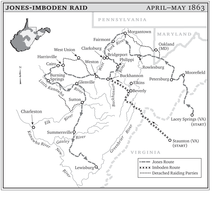 | Back to e-WV
| Back to e-WV
 The West Virginia Encyclopedia
The West Virginia Encyclopedia
 | Back to e-WV
| Back to e-WV
 The West Virginia Encyclopedia
The West Virginia Encyclopedia

Between April 24 and May 22, 1863, Confederate cavalry under Generals William E. ‘‘Grumble’’ Jones and John D. Imboden carried the Civil War into north central West Virginia. Their goals were to disrupt the Baltimore & Ohio Railroad at Oakland, Maryland, and at Grafton, cut telegraph communication, and weaken federal control in the area.
The Confederates made a two-prong attack, with Imboden riding from Staunton through Beverly to Buckhannon with 3,365 men. Jones led 2,100 men through Petersburg and Moorefield, skirmished at Greenland Gap in Hardy County, then was repulsed at Rowlesburg. He fell upon Morgantown, April 28, capturing supplies and many horses, including those of curiosity-seekers who came to town to learn what the excitement was. One of the Confederate raiders, future Postmaster General William Lyne Wilson, later returned to Morgantown as president of West Virginia University.
On April 29, at Fairmont, Jones waged the largest battle ever fought in that part of the state against a force of 500 regulars, home guards, and volunteers. There was some civilian involvement on both sides of the fight. The Confederates prevailed, burning the personal library of Francis Pierpont, governor of the Restored Government of Virginia, and exploding an iron railroad bridge across the Monongahela River. Jones linked up with Imboden at Buckhannon, skirmishing along the way, and together they moved to Weston. Jones continued west to Burning Springs, where he set fire to oil and the producing wells, oil boats, tanks, and other equipment, sending a sheet of flame floating down the Little Kanawha River. In his report to Gen. Robert E. Lee, Jones perhaps overestimated the amount of oil burned at 150,000 barrels.
Imboden, later associated with his brother, George, in the development of West Virginia coal mining, said in his report that the raiders covered 700 miles, fought two battles and several skirmishes, and captured nearly 700 prisoners, 1,000 cattle, and 1,200 horses. In addition to the oil, they burned 16 railroad bridges and a tunnel, two trains of cars and several boats. However, the damages were short-lived, and the Confederates never seriously threatened the area again.
Written by Gerald D. Swick
Stutler, Boyd. West Virginia in the Civil War. Charleston: Education Foundation, 1966.
Cohen, Stan. Civil War in West Virginia. Charleston: Pictorial Histories Publishing Company, 1979.
Swick, Gerald D. Confederate raiders rampage along the Monongahela. Clarksburg Exponent Telegram, 3/8/1998.